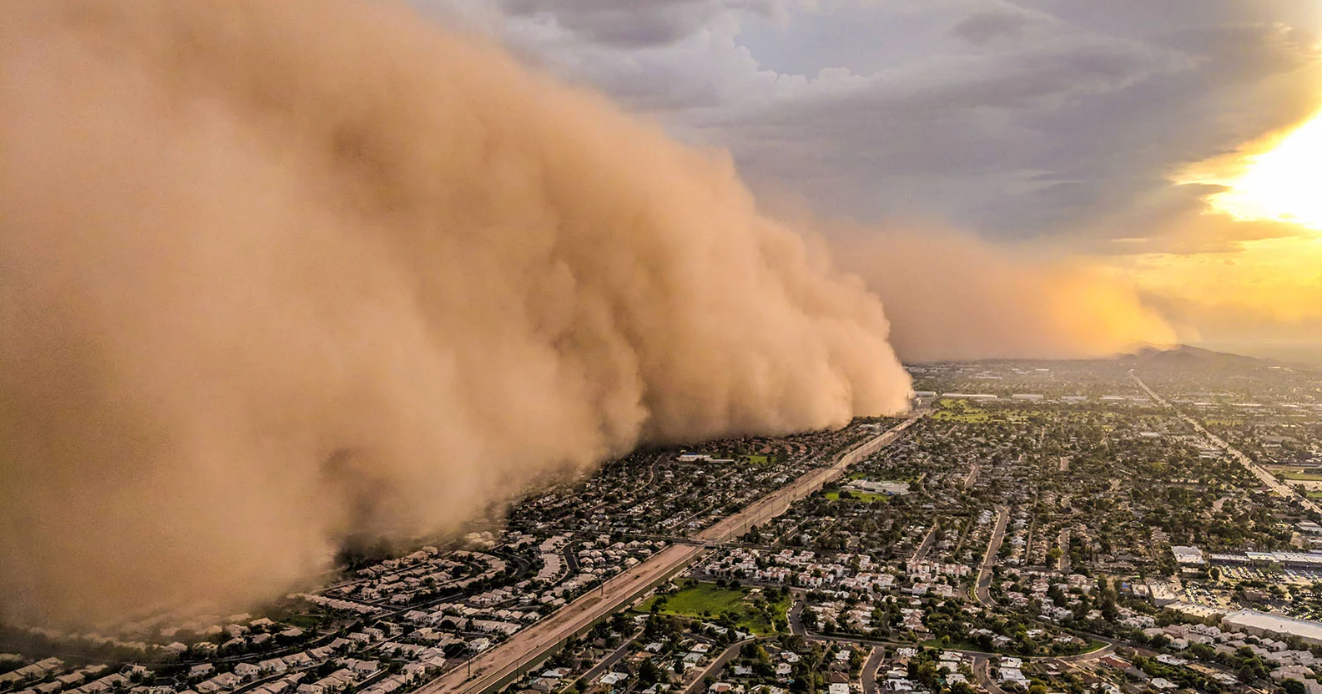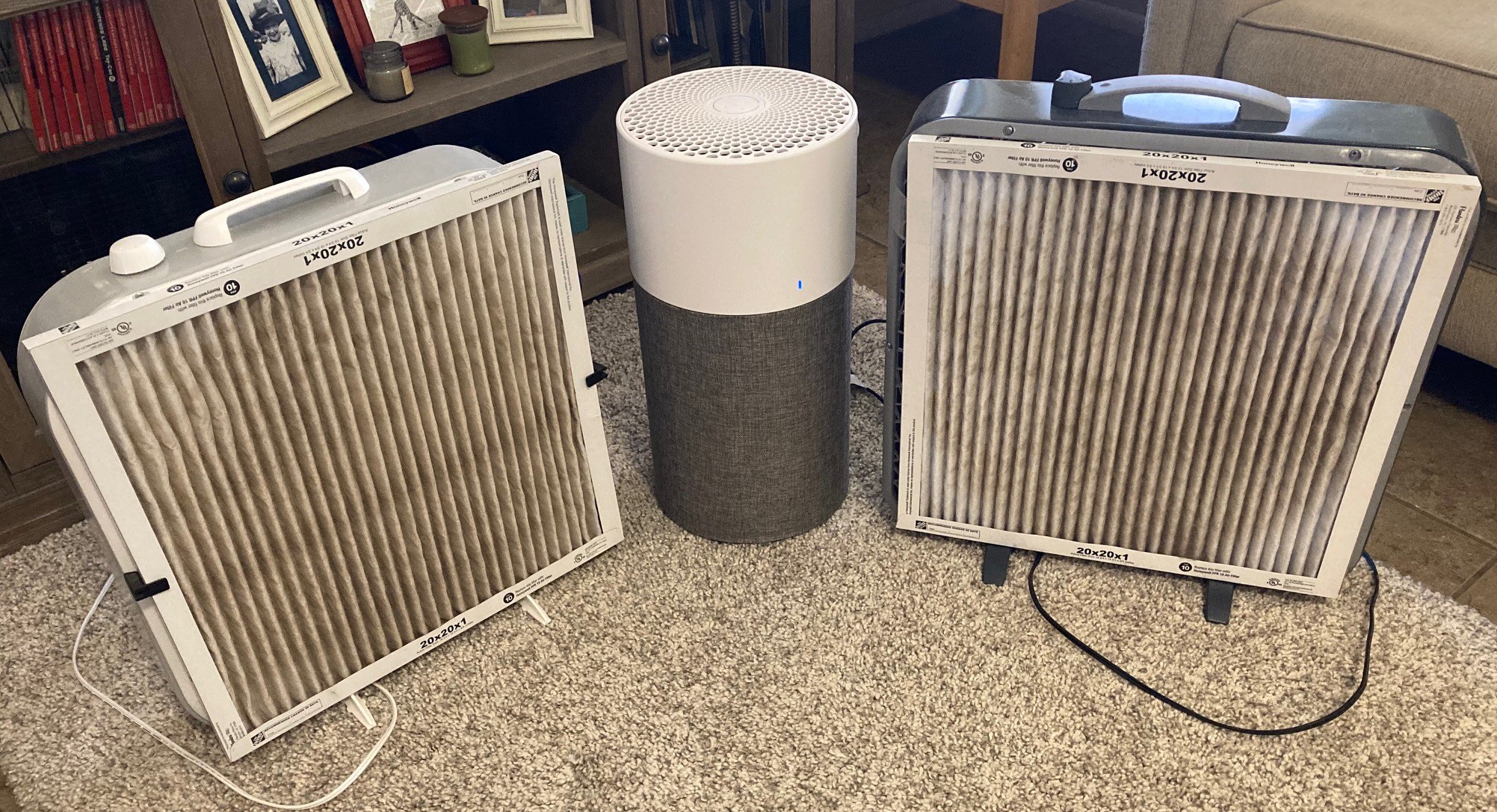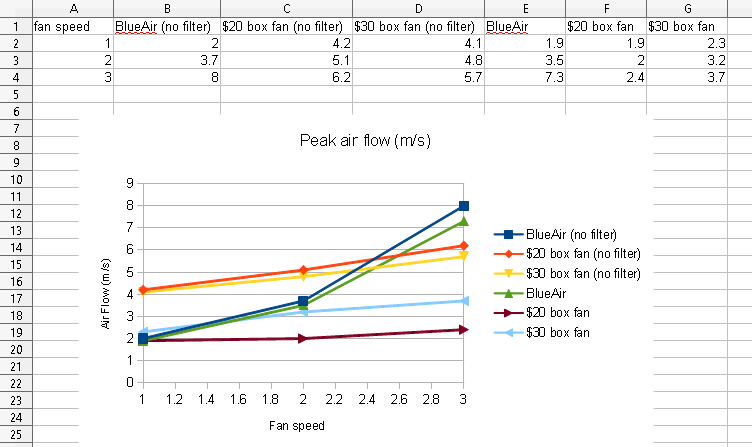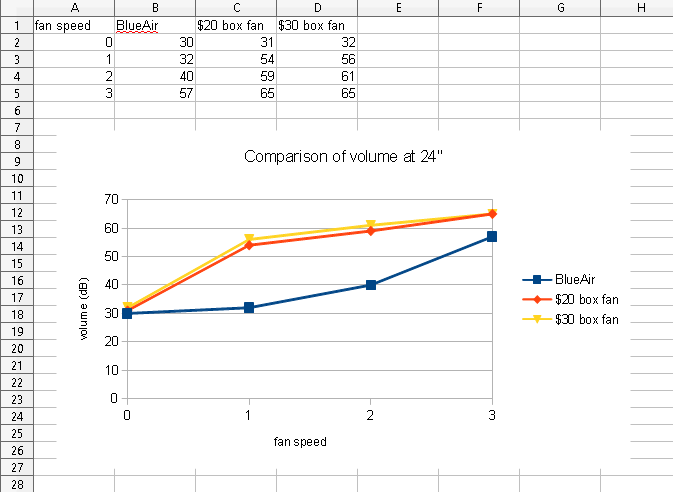
Living in the desert we are constantly struggling with dust and dirt. The air is so dry that the dust floats uninterrupted for days. Plus we have these amazing seasonal dust storms comically called haboobs that seem to blanket everything in dust.
The dust has finally sent me around the bend and so I brought my home made air filter into the house to see what it could do to help cut things down. This is a Lasko 20" B20200 box fan from Walmart combined with a 20"x20"x1" MERV13 furnace filter.
I had been eying getting a more expensive box fan to see if the extra power (CFM) does anything to improve the filter performance. So I picked up a Lasko 20" Power Plus B20540 box fan from Home Depot and an identical furnace filter to my original one. Not only did I want to see if the better fan was a better performer, but I also wanted to see if multiple air filters in multiple rooms made a difference. My thought is that each filter can only clear so much volume of air around themselves, and so you would need several thorough the house in order to be effective.
The ultimate goal was to pick up a real air filter for the house, or at least determine if a real filter was worth the price or offered any improvement in performance. I spent some time looking around and settled on the BlueAir 311 air filter as a likely candidate. It is sized right for a medium sized room, the price is not bad, and it looks nice compared to the usual fair. I'm also really taken with the idea of the filters having no frame so being easily collapsed during shipping. We don't put enough thought into minimizing waist, this seems like a very good design in my mind.

So after running my two home made fans for a few weeks with fresh filters on them, I noticed they were starting to get dirty. With limited evidence that they work I decided to pull the trigger on the BlueAir 311 and started to compare the three filters together.
As an aside, the box fan on the left has a paper baffle on the edges to improve air flow, while the box fan on the right does not. You can see the benefit of the baffles by looking at the corners of the filters, the one on the left has more dirt in the corner while the one on the right is very clean because of air flowing backwards through the filter. The overall surface area here is small, it is not a huge improvement, but I suspect it also improves how linear the air flow is, reducing turbulence and that in turn makes it more efficient as well.
I took some time to measure out each filter. The frontal area of the 20x20x1" filter is 2,030 cm^2, and the frontal area of the BlueAir filter is 2,620 cm^2. That is just the area the filter physically takes up, each filter material is folded into the filter itself and has a larger surface area. The 20" filter has one pleat every 20 mm, while the BlueAir has close to 7 pleats per 20 mm. Multiplying that out the surface area of the filter material is 4,050 cm^2 for the 20" filter and 17,530 cm^2 for the BlueAir filter. Basically the BlueAir has about 4x more surface area, making it have 4x less air resistance, assuming the filter material was identical.

Using my $8 anemometer I measured the peak wind speed of each fan with and without the filter installed at all three speeds. Keep in mind that for $8 this does not use real bearings on the impeller, just cast plastic bearings. I get a different reading at different orientations of the device. I have tried to orient everything the same, but these numbers should be treated as suspect or at least just approximations. Also peak air flow is not as interesting as taking a profile of flow across the whole filter and calculate CFM, but that is a lot more work, so you get this.
Looking at these numbers you can see that the box fans really struggle to push air through a MERV13 filter, they are loosing 2x or more of the air flow through the filter. It would be interesting to try using more than one filter in a wedge or box configuration to see if we can improve the flow. That is an experiment for another day, and one that should probably stay in the garage as well.
The BlueAir filter has almost no air loss with and without the filter in place, it is an extremely efficient design. At low speed it is moving about the same amount of air as the box fan (assuming air speed correlates with CFM, which it probably does not). It is also clear that there needs to be another speed between medium and high for this filter, the air flow doubles between medium and high.

Next I pulled out my dB meter and measured the noise volume of each fan at 24" from the motor and at a 45 degree angle from the center of air flow (to avoid any wind noise). The background noise in the room was around 30 dB for these measurements. The box fans are quite loud even on the lowest speed, easily being louder than the BlueAir on its highest 'turbo' setting. The BlueAir is basically inaudible on low, and you can barely tell it is on at its middle speed. The sound is loud but not horrible on high, much less annoying than either of the box fans.
The cost of the furnace filters is lower than the BlueAir filter. The BlueAir filter is around $40, $34 if you buy it in a subscription. While the furnace filter is around $20, $10 if you buy it in quantity. However in theory with the BlueAir having 4x the surface area it should, in theory, last 4x longer as well so these are more or less equivalent numbers. The BlueAir also has a carbon filter embedded in it, one that does not restrict the flow like the carbon filter glued to a furnace filtercarbon filter glued to a furnace filter that I tried previously.
The BlueAir unit I got is the newer one with a built in particle counter that can automatically ramp up the speed of the fan based on how dirty the air is. This sounds like a good call, but in practice it hardly ever moves off of its lowest setting. I took an incense stick and burned it in the room for a while and the fan never speed up, I had to put the stick right next to the inlet of the particle filter to trigger it. I also set the filter next to my very dusty blinds while dusting them and again it never picked up on the dust, not until I smacked my duster against the particle counter at least.
This is a nice idea in theory but it is flawed. The sensor has its own internal fan and it is trying to draw air in independent of the fan on the air filter. But that makes it compete with the air filter fan. It basically sits in a vacuum between the inlet and outlet of the filter. It would be better if incoming air somehow flowed past the sensor, although I can't see a reasonable way to make that happen. Also the fan itself is very slow to react to a disturbance, it may kick off if you have smoke hanging in the air but if you walk into the house and let in some dirty air it won't be able to detect it in time to remove the dust before it settles out. I ended up leaving the unit on medium permanently, it would be nice if the unit could still kick into high if it detected dust, but basically this is more gimmick than feature. Fortunately it was not an expensive upgrade.
Looking at all the above numbers it is clear that the BlueAir is the better air filter. It moves more air (at least moves it faster), is quieter, and in theory the filter will last a lot longer and can scrub out some organics from the air as well. It also looks much nicer, a selling point if your going to use it in your house. However it also cost $200 (w/filter) rather than $40 for the box fan (w/filter). That is 5x more, is it 5x better? I think it was worth the investment, but it is a bit of a tough sell. I don't understand why air filters are so expensive, they are way overpriced for what they provide for sure. This should cost less than $100 and the filters should be $20 apiece.
It remains to be seen if an air filter does anything to the dust in my house. The filters are collecting dirt for sure, but so does the filter on my furnace. The real question is do we see a reduction in dust in the house. I spent some time thoroughly dusting the house and hope to monitor it over time, but that is hardly a scientific approach. For now I will take it on faith that it is in fact helping, and hope to see some evidence in the future.
---
Matthias over at Woodgears.ca has recently done a more in-depth analysis of his air filters. He is using a particle counter and some smoke evenly spread around the room to more directly measure there ability to remove particles from the air. I'm hoping to resurrect my particle sensor, we will see if I can.
 David Tucker
David Tucker
Discussions
Become a Hackaday.io Member
Create an account to leave a comment. Already have an account? Log In.